View in other NatureServe Network Field Guides
NatureServe
Montana
Utah
Wyoming
Idaho
Wisconsin
British Columbia
South Carolina
Yukon
California
New York
Dwarf Purple Monkeyflower - Mimulus nanus
Other Names:
Diplacus nanus
State Rank Reason (see State Rank above)
Mimulus nanus is only known from a few extent occurrences in the state, plus two historical collections. Populations are generally small and in habitats susceptible to weed invasion. At least a few of the occurrences contain scattered spotted knapweed plants.
- Details on Status Ranking and Review
Population Size
Score2 - Small: Generally 2,000-10,000 individuals.
CommentData supports an estimate of approximately 10,000 plants. However, population levels likely fluctuate widely.
Range Extent
Score2 - Regional or State Endemic or Small Montana Range: Generally restricted to an area <100,000 sq. miles (equivalent to 2/3 the size of Montana or less) or Montana contributes 50% or more of the species’ range or populations OR limited to 2-3 Sub-basins in Montana.
Area of Occupancy
Score2 - Low: Generally occurring in 4-10 Subwatersheds (6th Code HUC’s).
Environmental Specificity
Score1 - Moderate: Species is restricted to a specific habitat that is more widely distributed or to several restricted habitats and is typically dependent upon relatively unaltered, good-quality habitat (C Values of 5-7).
Trends
ScoreNA - Rank factor not assessed.
CommentTrends are unknown, though there is no indication that the species' has experienced significant declines in Montana. Some habitat loss may have occurred.
Threats
Score1-2 - Medium to High.
Intrinsic Vulnerability
Score1 - Moderate Vulnerability: Specific biological attributes, unusual life history characteristics or limited reproductive potential makes the species susceptible to extirpation from stochastic events or other adverse impacts to its habitat and slow to recover.
Raw Conservation Status Score
Score
9 to 10 total points scored out of a possible 16 (Rarity factors and threats only).
General Description
PLANTS: A small annual with ascending to erect, branched stems that grow from 2 to 10 cm tall Plants have glandular-pubescent hairs. Source: Lesica et al. 2012.
LEAVES: Leaves are simple, sessile, and arranged opposite on the stem. Leaf blades are oblanceolate with entire margins and 5 to 15 mm long. Source: Lesica et al. 2012.
INFLORESCENCE: Few, clustered pairs of showy magenta flowers that grow on almost sessile stems (pedicels) from the upper leaf axils. Source: Giblin et al. [eds.] 2018; Lesica et al. 2012.
The specific epithet nanus translate directly from Latin to “dwarf” referring to this species’ small stature. Mimulus is derived from the Latin word mime, meaning “actor” or “mimic,” and the male diminutive -ulus (Merrium-Webster 2019). This is most likely referring to the mask-like appearance of the flowers.
Phenology
Dwarf Purple Monkeyflower flowers from May through August (Fraga in Jepson Flora Project 2018).
Diagnostic Characteristics
Montana has 5 native
Mimulus species with purplish flowers, of which 2 are perennial and 3 are annual plants. In Montana
Mimulus species have opposite, simple leaves. and in the axils of the upper leaves grows a pair of stemmed flowers. Flowers have 5-petals and 5-sepals, are bilaterally symmetrical and are tubular.
Dwarf Purple Monkeyflower-
Mimulus nanus*Habit: Planta are annual, often less than 10 cm tall.
*Herbage: Glandular-puberulent.
*Leaves: Petiolate below and sessile above, oblanceolate, entire, and 5 to 15 mm long.
*Flowers: The corolla is 1-2 cm long, magenta, and bilabiate with a yellow-spotted palate.
*Capsule: The mature capsule is 7-11 mm long.
North Idaho Monkeyflower-
Mimulus clivicola *Habit: Plants are annuals, often less than 10 cm tall.
*Herbage: Glandular-pubescent.
*Leaves: Sessile, oblong, entire, and about 1 cm long.
*Flowers: The corolla is 10-15 mm long, purple and bilabiate with unequal lobes and a yellow-spotted palate.
*Capsule: The mature capsule is 5-8 mm long and tubular.
Brewer's Monkeyflower-
Mimulus breweri *Habit: Plants are annuals, often less than 15 cm tall.
*Herbage: Stalked-glands (stipitate glandular).
*Leaves: Narrow blades (lanceolate) with entire margins (smooth), stemmed (petiolate), and 5-20 mm long.
*Flowers: The calyx is purplish. The corolla is 5-10 mm long, purple to red, and slightly bilabiate.
*Capsule: The mature capsule is 5-7 mm long.
Square-stem Monkeyflower-
Mimulus ringens*Habit: Plants are mat-forming, rhizomatous perennials, often more than 15 cm tall.
*Herbage: None (glabrous).
*Leaves: Sessile, lanceolate to oblanceolate, serrate, and 2-8 cm long.
*Flowers: The corolla is 20-27 mm long, purple, and bilabiate with a bearded palate.
*Capsule: The mature capsule is 10-12 mm long.
Lewis’ Monkeyflower-
Mimulus lewisii*Habit: Plants are rhizomatous perennials, often more than 15 cm tall.
*Herbage: Almost glabrous (glabrate) to glandular-pubescent.
*Leaves: Sessile to subsessile, lanceolate to ovate, serrate, and 1-7 cm long.
*Flowers: The corolla is 3-5 cm long, bilabiate, pink-purple or magenta with a yellow and purple-spotted palate.
*Capsule: The mature capsule is 12-16 mm long.
Species Range
Montana Range
Range Descriptions
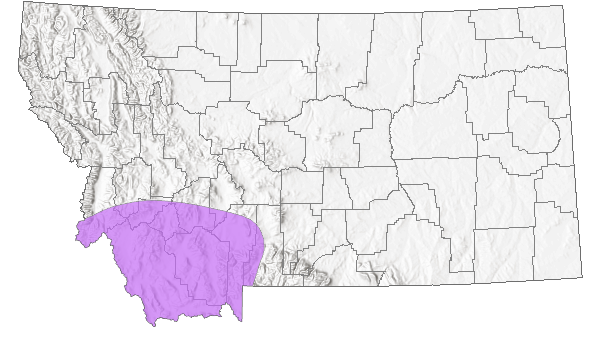
 Native
Native
Range Comments
Dwarf Purple Monkeyflower can be found from Washington to Montana and south to California, Nevada, Idaho, and Wyoming (Lesica et al. 2012).
Observations in Montana Natural Heritage Program Database
Number of Observations: 28
(Click on the following maps and charts to see full sized version)
Map Help and Descriptions
Relative Density
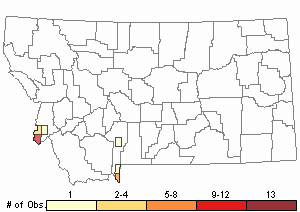
Recency
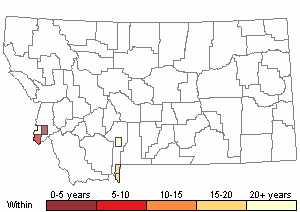
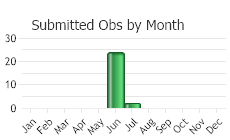
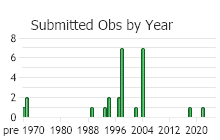
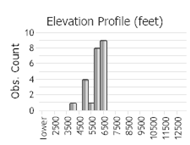 (Observations spanning multiple months or years are excluded from time charts)
(Observations spanning multiple months or years are excluded from time charts)
Habitat
Dwarf Purple Monkeyflower prefers vernally moist, sandy soils of open slopes from montane to lower subalpine zones in Montana (Lesica et al. 2012). It can usually be seen in sagebrush scrub, Juniper woodlands, or Pinus ponderosa zones in Idaho (Lorain et al. 1989).
Ecology
ASSOCIATED SPECIESOregon populations of
Lupinus lepidus var.
cusickii and Dwarf Purple Monkeyflower was found to be common associated (Newton et al. 2010).
Canopy cover types associated with Dwarf Purple Monkeyflower include Engelmann Spruce-Subalpine Fir (
Picea engelmannii-Abies lasiocarpa), Whitebark Pine (
Pinus albicaulis), Interior Douglas Fir (
Pseudotsuga menziesii var.
glauca), Western Larch (
Larix occidentalis), Grand Fir (
Abies grandis), Western White Pine (
Pinus monticola), Lodgepole Pine (
Pinus contorta), Interior Ponderosa Pine (
Pinus ponderosa var.
scopulorum), and mixed conifer forest (Meinke 1995).
ECOLOGICAL DISTRIBUTIONDwarf Purple Monkeyflower exhibits an affinity for moderate insolation (Robinson 1967). In a study of several herbaceous species along a vegetation gradient caused by rain shadow, Dwarf Purple Monkeyflower consistently preferred moderately sun exposed conditions throughout its range in the gradient. It was however, largely confined to the lower xeric parts of the study transect.
NUTRITIONAL VALUEDwarf Purple Monkeyflower is consumed by grazing animals because of it high protein potential and high palatability (USDA 2019).
POLLINATIONInvertebrates may potentially use Dwarf Purple Monkeyflower seeds as a major food source (Meinke 1995). Primary pollinators of Dwarf Purple Monkeyflower are native solitary and semi-social bees (Meinke 1995). Beeflies occasionally visit plants and are secondary pollinators (Meinke 1995). Dwarf Purple Monkeyflower technically has the ability to self-pollinate, but requires pollinators to maintain gene flow and effective reproduction (Meinke 1995).
Potential and Known Pollinators:
The following animal species have been reported as pollinators of this plant species or its genus where their geographic ranges overlap:
Bombus vagans,
Bombus bifarius,
Bombus centralis,
Bombus flavifrons, and
Bombus pensylvanicus (Thorp et al. 1983, Colla and Dumesh 2010).
HORTICULTUREIt is also used as a nursery stock product (USDA 2019).
Reproductive Characteristics
Dwarf Purple Monkeyflower has medium seed abundance, rapid seed spread rate, and medium seedling vigor (USDA, NRCS 2019).
FLOWERS
The mature flowers of Dwarf Purple Monkeyflower have a 1 to 2 cm long, magenta corolla that is bilabiate, with hairy, subequal lobes and a yellow-spotted palate (Lesica et al. 2012). The calyx of mature flowers is 5 to 8 mm long with 1 to 2 mm long equal-length teeth. The pedicels are half as long as the calyx.
FRUIT
The mature fruit of Dwarf Purple Monkeyflower are many-seeded, ellipsoidal capsules that are 7 to 11 mm long (Lesica et al. 2012).
LIFE CYCLE
Dwarf Purple Monkey flower is an annual plant (Lesica et al. 2012). It flowers from late spring through late summer (Fraga in Jepson Flora Project 2018).
SEED DISPERSAL
Dwarf Purple Monkeyflower seeds are primarily dispersed through wind (Meinke 1995). Due to their common presence along roads in the Pacific Northwest, vehicles are also a method of seed dispersal in this region (Meinke 1995). Plants have also been observed growing on or near ant mounds, suggesting that seeds may be spread on a local scale by foraging ants (Meinke 1995).
Stewardship Responsibility
Threats or Limiting Factors
STATE THREAT SCORE REASON
Reported threats to Montana's populations of Dwarf Purple Monkeyflower include invasive species, timber management, and road construction and maintenance (MTNHP Threat Assessment 2021). Due to their shared habitat preference, several populations of Dwarf Purple Monkeyflower are infested with Spotted Knapweed (Centaurea stoebe). Timber harvest and road construction may permanently destroy Dwarf Purple Monkeyflower plants and habitat. These activities also greatly increase the chances of noxious weed introduction.
References
- Literature Cited AboveLegend:
 View Online Publication
View Online Publication Lesica, P., M.T. Lavin, and P.F. Stickney. 2012. Manual of Montana Vascular Plants. Fort Worth, TX: BRIT Press. viii + 771 p.
Lesica, P., M.T. Lavin, and P.F. Stickney. 2012. Manual of Montana Vascular Plants. Fort Worth, TX: BRIT Press. viii + 771 p. MTNHP Threat Assessment. 2021. State Threat Score Assignment and Assessment of Reported Threats from 2006 to 2021 for State-listed Vascular Plants. Botany Program, Montana Natural Heritage Program, Helena, Montana.
MTNHP Threat Assessment. 2021. State Threat Score Assignment and Assessment of Reported Threats from 2006 to 2021 for State-listed Vascular Plants. Botany Program, Montana Natural Heritage Program, Helena, Montana.
- Additional ReferencesLegend:
 View Online Publication
View Online Publication
Do you know of a citation we're missing? Jones, W. W. 1901. Preliminary flora of Gallatin County. M.S. Thesis. Bozeman, MT: Montana State College. 78 pp.
Jones, W. W. 1901. Preliminary flora of Gallatin County. M.S. Thesis. Bozeman, MT: Montana State College. 78 pp. Lesica, P., M.T. Lavin, and P.F. Stickney. 2022. Manual of Montana Vascular Plants, Second Edition. Fort Worth, TX: BRIT Press. viii + 779 p.
Lesica, P., M.T. Lavin, and P.F. Stickney. 2022. Manual of Montana Vascular Plants, Second Edition. Fort Worth, TX: BRIT Press. viii + 779 p. Quire, R.L. 2013. The sagebrush steppe of Montana and southeastern Idaho shows evidence of high native plant diversity, stability, and resistance to the detrimental effects of nonnative plant species. M.Sc. Thesis. Bozeman, MT: Montana State University. 124 p.
Quire, R.L. 2013. The sagebrush steppe of Montana and southeastern Idaho shows evidence of high native plant diversity, stability, and resistance to the detrimental effects of nonnative plant species. M.Sc. Thesis. Bozeman, MT: Montana State University. 124 p.
- Web Search Engines for Articles on "Dwarf Purple Monkeyflower"





